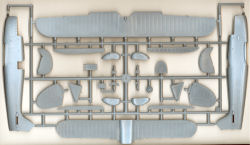
Classic Airframes 1/48 He 51 Legion Condor Kit First Look
By Michael Benolkin
| Date of Review | August 2008 | Manufacturer | Classic Airframes |
|---|---|---|---|
| Subject | He 51 Legion Condor | Scale | 1/48 |
| Kit Number | 4149 | Primary Media | Styrene, Resin |
| Pros | Nice detailing, relatively simple build | Cons | |
| Skill Level | Intermediate | MSRP (USD) | Out of Production |
First Look
 |
 |
 |
The Heinkel He 51 was a biplane fighter development of the He 49 trainer. While also designated as a trainer under the Treaty of Versailles, the He 51 was the first fighter of the new Luftwaffe. First flown in 1933, production airframes followed a year later.
The He 51 was dispatched to support combat operations in the Spanish Civil War, flown by German 'volunteers'. In the initial days of the war, the He 51 easily swept the skies of surplus WWI era fighters, but soon ran into the likes of the Polikarpov biplane I-15 and monoplane I-16. The He 51 was soon out-classed and the hunters quickly became targets.
He 51 operations continued though the type was re-roled into close air support as the German pilots developed that concept that would later be used successfully in World War II. Back in Germany, the He 51 soon fell into secondary roles as the new Bf 109 fighters started into service and by the start of World War II, the aircraft was indeed fulfilling its role under the Versailles Treaty as a trainer.
Classic Airframes has developed a new-tool Heinkel He 51 in 1/48 scale and released it in two boxings. This one represents the early He 51s that served in the Legion Condor in Spain. The kit is molded in light gray styrene and presented on two parts trees, one clear windshield, and three resin parts (main wheels and pilot's seat). This is the closest Classic Airframes has come to an all-styrene kit that I can recall.
Assembly of this kit is very straightforward. With no resin needed in the construction of the airframe, the lower wing attaches directly to the underside of the fuselage. As with any kit, the modeler must take care to ensure a proper alignment of the wings and tail surfaces.
With the lower wings on the fuselage, you need only add the cabane struts, wing struts and upper wing to complete the main assemblies. Experienced biplane modelers have different tools and methods to keep everything aligned during the assembly process. I've like the airframe jig I used in the Classic Airframes 1/48 Ro 37 build as this can be adjusted to accommodate different size and scaled projects. I don't know if this tool is back in production, but it certainly makes many of my projects go together much smoother.
The other nice thing about this subject is the landing gear. This is not a fragile assembly as with some other subjects so scaling this down to 1/48 still makes for a simple solution.
One last note about these instructions, some of the previous kits have had somewhat ambiguous directions on where parts go in the assembly process. Such is not the case here. Everything is clearly laid out and the instructions even provide clear rigging instructions should you wish to complete this model with all of the structural wires used to hold this aircraft together. Nice work!
The kit provides markings for six Spanish Civil War Heinkels:
- He 51, 3.J/88, 2-98, Feb 1938, as flown by Lt Kurt Strümpeil
- He 51, 3.J/88, 2-64, 1937
- He 51, 2-85, 1937, as flown by Dr Heinrich Neumann
- He 51, 2-102, 1938, as flown by Dr Heinrich Neumann
- He 51, 3.J/88, 2-78, 1938, as flown by Oblt Adolf Galland
- He 51, 2-4, Aug 1936, as flown by Oblt Hannes Trautloft
A note on these decals. One thing that has been a pet peeve of mine has been the trend to create decals that require the modeler to layer one atop another ro recreate the intended art. This is done to compensate for one famous US decal printer's problem with maintaining print registration across multiple layers of colors. Rather than deal with the hassles of sending out of register decals back for reprinting, it is easier for some to simply let you do the job of stacking decals yourself.
Classic Airframes had been using this same decal printer and multilayer technique for the many of their previous releases, but recently switched to Cartograf as they seem to have better quality printing. Look at the decals in this set for example. There are lots of colors on this sheet and most of the decals are multi-colored. Not one of them require you to stack decals one atop another. One marking - one decal, just as it should be. Kudos to Classic Airframes for this significant improvement in their decal quality.
This has to be one of Classic Airframes' easiest 'multimedia' kit to date as the vast majority of parts are styrene. If you want to build something colorful and different as one of these early Spanish Civil Warriors was, here is a great entry-level subject to step up to and try your hand at limited run kits. Don't get me wrong, this kit will still require good modeling experience and skills to get everything properly fitted, as with any limited run kit, but the layout of the aircraft's design, the implementation of that design in this kit, and the very limited use of resin parts will make this a good 'trainer' into the greater wealth of subjects only available from companies like Classic Airframes.
My most sincere thanks to Classic Airframes for the review sample!







